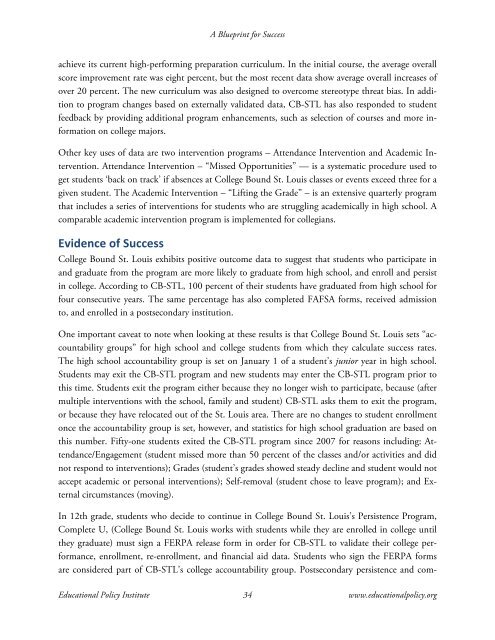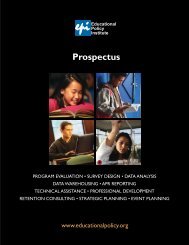A BluePrint for Success: Case Studies of Successful - Educational ...
A BluePrint for Success: Case Studies of Successful - Educational ...
A BluePrint for Success: Case Studies of Successful - Educational ...
Create successful ePaper yourself
Turn your PDF publications into a flip-book with our unique Google optimized e-Paper software.
A Blueprint <strong>for</strong> <strong>Success</strong><br />
achieve its current high-per<strong>for</strong>ming preparation curriculum. In the initial course, the average overall<br />
score improvement rate was eight percent, but the most recent data show average overall increases <strong>of</strong><br />
over 20 percent. The new curriculum was also designed to overcome stereotype threat bias. In addition<br />
to program changes based on externally validated data, CB-STL has also responded to student<br />
feedback by providing additional program enhancements, such as selection <strong>of</strong> courses and more in<strong>for</strong>mation<br />
on college majors.<br />
Other key uses <strong>of</strong> data are two intervention programs – Attendance Intervention and Academic Intervention.<br />
Attendance Intervention – “Missed Opportunities” — is a systematic procedure used to<br />
get students ‘back on track’ if absences at College Bound St. Louis classes or events exceed three <strong>for</strong> a<br />
given student. The Academic Intervention – “Lifting the Grade” – is an extensive quarterly program<br />
that includes a series <strong>of</strong> interventions <strong>for</strong> students who are struggling academically in high school. A<br />
comparable academic intervention program is implemented <strong>for</strong> collegians.<br />
Evidence <strong>of</strong> <strong>Success</strong><br />
College Bound St. Louis exhibits positive outcome data to suggest that students who participate in<br />
and graduate from the program are more likely to graduate from high school, and enroll and persist<br />
in college. According to CB-STL, 100 percent <strong>of</strong> their students have graduated from high school <strong>for</strong><br />
four consecutive years. The same percentage has also completed FAFSA <strong>for</strong>ms, received admission<br />
to, and enrolled in a postsecondary institution.<br />
One important caveat to note when looking at these results is that College Bound St. Louis sets “accountability<br />
groups” <strong>for</strong> high school and college students from which they calculate success rates.<br />
The high school accountability group is set on January 1 <strong>of</strong> a student’s junior year in high school.<br />
Students may exit the CB-STL program and new students may enter the CB-STL program prior to<br />
this time. Students exit the program either because they no longer wish to participate, because (after<br />
multiple interventions with the school, family and student) CB-STL asks them to exit the program,<br />
or because they have relocated out <strong>of</strong> the St. Louis area. There are no changes to student enrollment<br />
once the accountability group is set, however, and statistics <strong>for</strong> high school graduation are based on<br />
this number. Fifty-one students exited the CB-STL program since 2007 <strong>for</strong> reasons including: Attendance/Engagement<br />
(student missed more than 50 percent <strong>of</strong> the classes and/or activities and did<br />
not respond to interventions); Grades (student’s grades showed steady decline and student would not<br />
accept academic or personal interventions); Self-removal (student chose to leave program); and External<br />
circumstances (moving).<br />
In 12th grade, students who decide to continue in College Bound St. Louis’s Persistence Program,<br />
Complete U, (College Bound St. Louis works with students while they are enrolled in college until<br />
they graduate) must sign a FERPA release <strong>for</strong>m in order <strong>for</strong> CB-STL to validate their college per<strong>for</strong>mance,<br />
enrollment, re-enrollment, and financial aid data. Students who sign the FERPA <strong>for</strong>ms<br />
are considered part <strong>of</strong> CB-STL’s college accountability group. Postsecondary persistence and com-<br />
<strong>Educational</strong> Policy Institute 34 www.educationalpolicy.org




